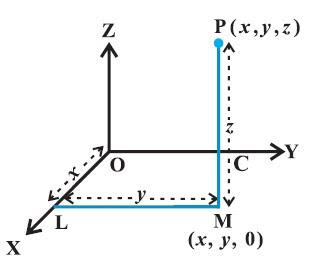 Let us learn about Coordinates of a Point in Space,
Let us learn about Coordinates of a Point in Space,Having chosen a fixed coordinate system in the
space, consisting of coordinate axes, coordinate
planes and the origin, we now explain, as to how,
given a point in the space, we associate with it three coordinates (x,y,z) and conversely, given a triplet of three numbers (x, y, z), how, we locate a point in the space.
Given a point P in space, we drop a
perpendicular PM on the XY-plane with M as the
foot of this perpendicular (Fig.). Then, from the point M, we draw a perpendicular
ML to the x-axis, meeting it at L. Let OL be x, LM be y and MP be z. Then x,y and z
are called the x, y and z coordinates, respectively, of the point P in the space. In
Fig, we may note that the point P (x, y, z) lies in the octant XOYZ and so all x, y,
z are positive. If P was in any other octant, the signs of x, y and z would change accordingly. Thus, to each point P in the space there corresponds an ordered triplet
(x, y, z) of real numbers.
Hope the above explanation helped you, now let me give you some examples on Coordinates of a Point in Space.


 b ≠ 0. It is to be noted that only two numbers can be added or multiplied at a time.
b ≠ 0. It is to be noted that only two numbers can be added or multiplied at a time.